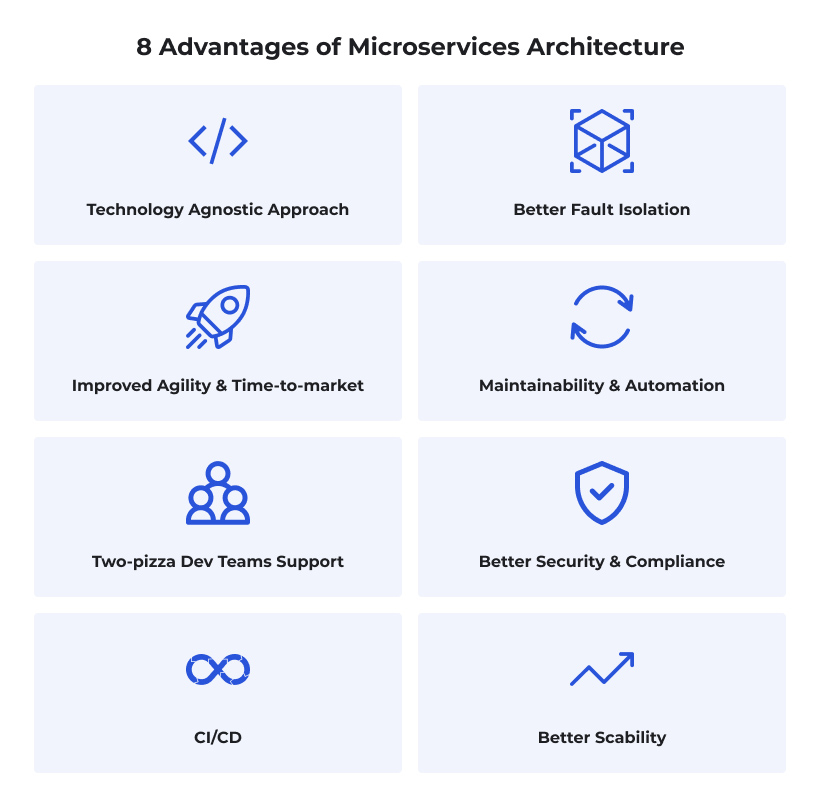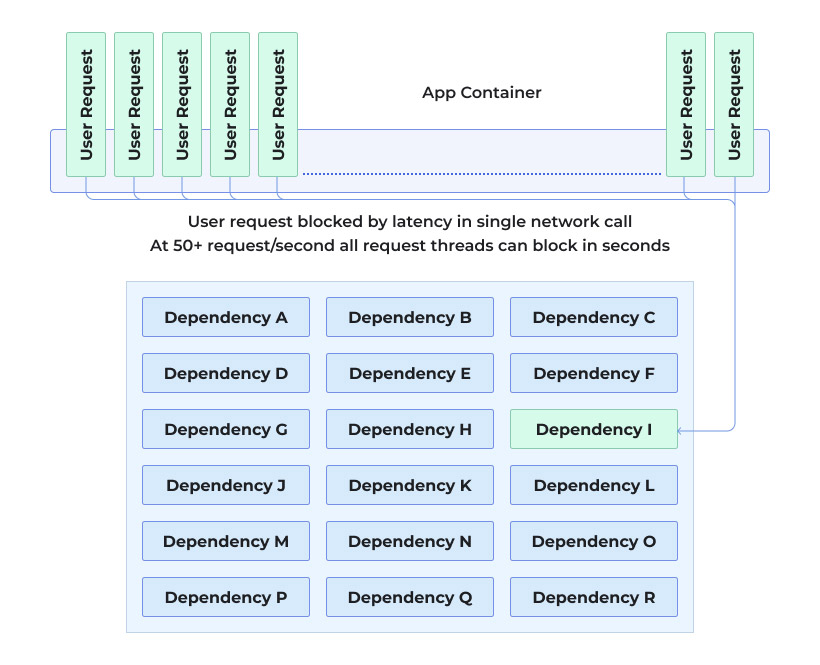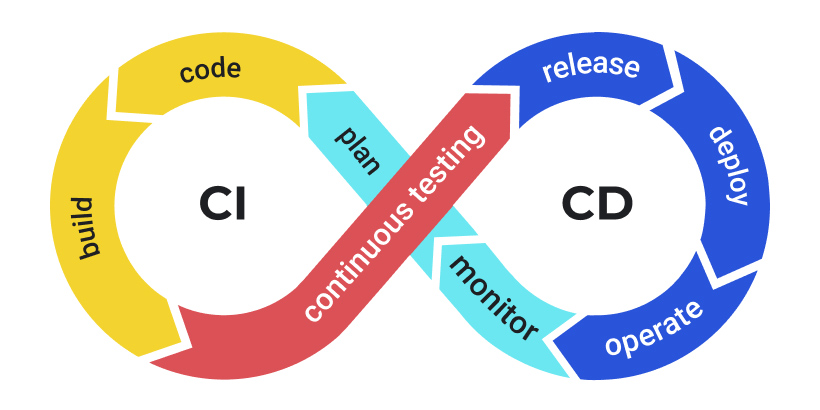The microservice architecture market has been growing at a CAGR of 20% reaching a global value of $6.4 billion in 2024. The growing popularity of this approach is rooted in the idea of breaking down extensive software projects into smaller, autonomous components with loose connections. Developers increasingly acknowledge the benefits of microservices such as flexibility and agility in API management and the execution of specific tasks. In essence, microservices serve as an alternative architectural solution for the creation of intricate, primarily web-based applications. They have risen in prominence as an advancement beyond Service Oriented Architecture (SOA), which was conceived to address the drawbacks of traditional monolithic architectures.
In today’s article, we are going to delve deeper into the essence of microservice architecture and discuss the many advantages of microservices along with their limitations. The following material will provide a clear understanding of the microservices business benefits and the ways this approach can increase the efficiency of the development processes and business operations.
The Essence of Microservices Architecture
Before we get to the discussion of the advantages and disadvantages of microservices, let us get a good idea of the concept. While there isn't a precise definition, the essence of microservices lies in their representation of a software architectural style. In this model, complex applications are decomposed into a collection of small, lightweight, independently deployable, self-contained, and highly autonomous services. Each service operates with a high degree of independence, responsible for its specific process. This stands in contrast to the monolithic approach, where applications are developed as a single entity.
Microservices interact with one another as needed to fulfill particular actions, communicating via language-agnostic APIs. This method mirrors a team dynamic, wherein each member focuses on their specialized task, empowered with the responsibility, freedom, and trust to execute it optimally. Such an approach typically yields high productivity.
While microservices architecture can be adopted from the ground up for application development, even existing monolithic applications can be subdivided into tightly focused services. Why pursue this strategy? When implemented effectively, microservices offer a myriad of advantages. Let's explore these benefits further.
What are the advantages of microservices? Why opt for microservices in your project?
Because they handle a specific segment of your product's functionality, offering inherent modularity that facilitates independent scalability. With microservices, you can expand application access without overhauling the entire codebase. Instead, you simply adjust the microservices and their scope, ensuring corresponding services align to enhance overall functionality.
Why are microservices important?
Because they offer swift deployment and specialized functionality.
- They enhance deployment speed by operating within their own containerized environments, enabling seamless migration without disrupting previous setups. This ensures integrity for ongoing and future projects, not to mention current performance optimization.
- They empower developers by storing application components within individual containers. This allows for independent updates, fixes, and enhancements without the need to navigate through extensive codebases. Developers can precisely target issues and apply fixes with high precision, simplifying maintenance and improving agility. Additionally, updates and feature enhancements are streamlined, as changes are isolated to the specific microservice being modified.
- They support diverse language usage, aligning with our technology stack at Code & Pepper. Microservices enable us to adapt and scale products efficiently, leveraging appropriate languages for specific requirements.
- They facilitate significant cost reductions compared to monolithic architectures. In monolithic setups, every change, particularly later in the project lifecycle, can be complex and costly. Interconnected components create a ripple effect where modifications in one area impact others, leading to increased effort and expenses. In contrast, microservices allow focused work, minimizing the need to estimate costs associated with collateral effects such as additional quality assurance, bug fixes, and post-launch support.
Top 8 Benefits of Microservices Architecture
Now that we have established a strong understanding of microservices, let us take a closer look at the benefits of microservices architecture and the opportunities they present for development teams and businesses in general.

Improved agility and time-to-market
So, what are the benefits of microservices architecture? Let’s start with the basics. As enterprises try to enhance their agility, they are embracing microservices as a means to accelerate their time-to-market. A microservices application architecture facilitates the swift delivery of software by enabling developers to focus on discrete, independent components of an application. These components can be promptly deployed and tested without impacting the remainder of the application.
The adaptability inherent in a microservices application architecture facilitates faster and more streamlined application development and upgrades. Developers gain the ability to swiftly construct or modify a microservice, seamlessly integrating it into the architecture with reduced risk of coding conflicts or service interruptions. Furthermore, thanks to the autonomous nature of each microservice, teams are liberated from concerns regarding coding conflicts and no longer need to await the completion of slower-moving projects before launching their segment of the application.
Microservices also align with the Continuous Integration, Continuous Delivery development philosophy. It enables responsiveness to security threats and the incorporation of emerging technologies as they emerge. Consequently, users experience a continuously evolving and future-proof product. These advantages of microservice architecture will be discussed in greater detail in further sections.
High maintainability and automated deployment
The microservices ecosystem is more manageable to support and maintain due to the heightened autonomy of its components. Each service can undergo frequent updates and independent deployment, unaffected by other services. Leveraging modern DevOps tools and adhering to CI/CD best practices for automated deployment enables customization of this process according to each team's evolving requirements. This fosters efficient and error-free application development and deployment.
Better fault isolation for more resilient applications
One of the core microservices advantages is that the likelihood of one service failure adversely affecting other application components is reduced as each microservice operates independently. However, in large distributed architectures, numerous dependencies exist, necessitating developers to shield the application from shutdowns caused by dependency failures.

Microservices architecture offers mechanisms to prevent cascading failures, such as Circuit Breakers, which prevent depletion of server resources when a calling service is stalled due to an unresponsive service. It's advisable to minimize Remote Procedure Calls (RPCs) between microservices, as they can trigger cascading failures.
When refactoring an operation into a separate service, it's essential to redesign the operation to operate fully asynchronously. Leveraging the message bus helps insulate services from each other, mitigating the risk of failures due to temporary outages, redeployments, or downtime in one service.
Programming language and technology agnostic
When developing a microservices-based application, developers have the flexibility to connect microservices written in any programming language and running on any platform. This provides greater versatility in selecting programming languages and technologies that align with the project's requirements and the team's expertise. By embracing a programming language-agnostic approach, developers gain the ability to swiftly adopt emerging and evolving technologies. This liberates developers from being bound to a single technology stack, allowing them to employ the most suitable tool for each task.
The advantages of microservices architecture being technology agnostic encompass:
- Increased productivity: Developers can leverage their familiarity with preferred tools, leading to heightened productivity and reduced learning curves.
- Greater flexibility: Technology-agnostic microservices offer flexibility in utilizing the most appropriate languages and tools for each project.
- Improved ROI: By utilizing existing resources and swiftly adopting new technologies, businesses can enhance return on investment, which is one of the core microservices business benefits.
- Enhanced integration: Microservices, being language-agnostic, facilitate easier integration with legacy systems.
Better data security and compliance
One of the key advantages of microservices architecture lies in its ability to adopt a more refined approach to data security. With each service tasked with specific responsibilities, implementing security measures at the service level becomes notably simpler. This method offers enhanced security compared to the conventional approach of storing all data within a single monolithic database accessible by the entire application.
Developers commonly utilize secure APIs to connect microservices. By ensuring that only specifically authorized applications, users, and servers can access the data it processes, a secure API provides robust protection for sensitive information. In scenarios where microservices manage sensitive health, financial, or other confidential data, a secure API affords developers comprehensive control over the data accessible to the broader application and its users. This facilitates compliance with standards like HIPAA, GDPR, and other data security regulations.
It is future-proof
Microservices offer future-proofing capabilities. The architectural design, characterized by loosely coupled small elements, permits architectural decisions and upgrades to be made at the individual microservice level, which is notably less costly than upgrading the entire system.
For instance, when refactoring a microservice, the impact is confined to the size of the microservice, which is typically much smaller than the entire system. This enables gradual upgrades of the entire system, service by service, while ensuring the API contract with other microservices remains intact. In the event of a failure in a microservice architecture, the impact is typically localized to the affected microservice, containing the blast radius and allowing the rest of the system to potentially continue operating, even without an orchestration mechanism like Kubernetes.
Support for two-pizza development teams
In a microservices application architecture, each team assumes responsibility for one or more services, a structure that aligns with the "two-pizza" development team philosophy. Coined by Amazon CEO Jeff Bezos, the Two-Pizza Rule suggests that a development team should be small enough to be fed by two pizzas. Essentially, the team size should enable effective collaboration and familiarity among members.
This principle echoes the values of the Agile Manifesto, prioritizing "individuals and interactions over processes and tools." In the realm of microservices, each team operates autonomously on its designated service(s). This autonomy enables swift decision-making and progress without the need for extensive coordination with other teams, thereby enhancing efficiency and fostering rapid innovation.
CI/CD
CI/CD revolves around Continuous Integration (CI), Continuous Delivery (CD), and Continuous Deployment (CD). Continuous Integration involves frequent merging of code changes into the main branch. Automated build and testing procedures ensure that the code in the main branch consistently meets production standards.
Continuous Delivery ensures that code changes passing the CI process are automatically deployed to a production-like environment. Although deployment to the live production environment might require manual approval, the process is otherwise automated. The objective is to keep the code perpetually ready for deployment into production.

CI/CD objectives for microservices architecture:
- Independent service development and deployment: Each team can develop and deploy the services they own autonomously, without causing disruptions to other teams.
- Validation of service versions: Before introducing a new service version to production, it undergoes deployment in development, testing, and quality assurance environments for validation. Quality gates are enforced at each stage.
- Version compatibility: New service versions can be deployed alongside previous versions, ensuring a seamless transition and minimal disruption.
- Access control policies: Robust access control policies are established to govern service deployment and management.
- Trustworthy container images: For containerized workloads, confidence in the container images deployed to production is maintained through thorough validation processes.
Disadvantages of Microservices to Consider
Our discussion of the advantages and disadvantages of microservices architecture would not be complete without this section. Although the benefits of a microservices architecture are evident, this architectural approach does come with its set of challenges. Primarily, the complexity inherent in any distributed system stands out as a significant drawback. Here's a rundown of some potential disadvantages of microservices:
- Complex communication between services: As every component operates as an independent service, managing requests between modules becomes intricate. Developers often need to write additional code to ensure seamless communication, and as time progresses, complications may arise due to latency in remote calls.
- Increased resource usage: With more services comes the need for additional resources, including multiple databases and transaction management systems, which can become tough to handle.
- Difficulty in global testing: Unlike monolithic approaches, where launching the application on a server and verifying connectivity suffices, microservices demand thorough confirmation of each dependent service before testing can commence.
- Suitability for large vs. small companies: While a microservice architecture offers significant benefits for large enterprises, their implementation can be slower and overly complex for smaller companies aiming for rapid iteration without getting entangled in intricate orchestration processes.
However, it's worth noting that with the right approach tools and adequately trained personnel, many of these drawbacks can be mitigated effectively. Thanks to the benefits of microservices architecture, this approach undeniably stands as a dependable and proven method for constructing future-ready applications.
As we navigated through the primary advantages of microservices architecture, we demonstrated that numerous concerns and challenges associated with this approach are addressable and resolvable with the support of proficient technical teams and strategic technology partnerships.
Conclusion
Having grasped the primary advantages of microservices application architecture, you may contemplate adopting a microservices strategy for your enterprise. While microservices architecture may not be universally applicable, there are certainly situations and contexts where a monolithic architecture can be more suitable. If you find yourself contemplating the development of a digital solution using microservices, or if you have any questions, feel free to reach out to the Light IT Global team. We are eager to offer any assistance needed to further enhance the success of your business.




